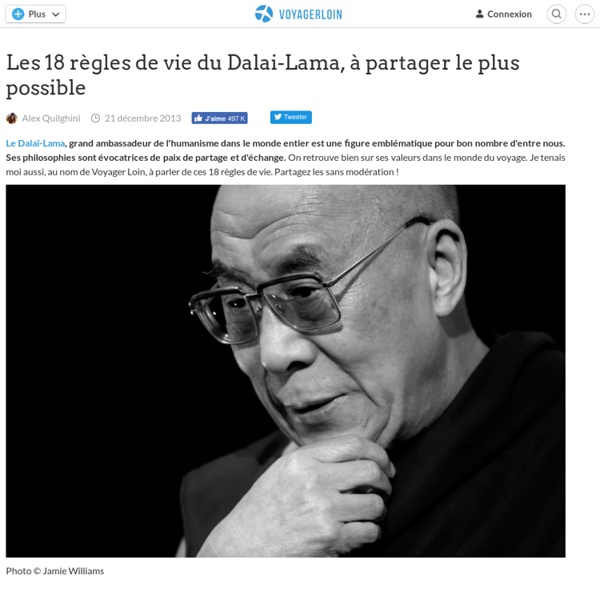



http://voyagerloin.com/culture/les-18-regles-vie-du-dalai-lama-partager-possible/
Related: sevlivres • Philosophie • Livres-meditations bien êtrebusinessinsider Over the past 30 years, three-quarters of eastern US tree species have been shifting to the west, and at an astonishing rate of around 15.4 kilometres per decade (9.5 miles). That's weird, because scientists have long predicted that the effects of climate change would send species towards the poles in search of familiar climates, but since 1980, more eastern trees have been moving west instead of north. And at this stage, it's not entirely clear why. And the fact that more eastern trees are moving westward than northward isn't even the strangest part. Researchers estimate that even if we took certain knock-on effects of climate change into consideration, such as changes in rainfall and precipitation, it can only explain a fraction of the movement. Something else is going on here - or many somethings in accumulation - and scientists are still trying to make sense of it.
Dipping Into a French Melting Pot Photo Pursuits By FARAI CHIDEYA When is not just Paris? When it’s a window onto Dakar, Senegal; or Morocco; or Mumbai, India; or Moscow. The city successfully markets itself as a playground in which to sample France’s vast traditional cultural and gastronomic output, from wines to cheeses to literature and fashion. Organic Farming is Bad for the Environment Marketing sometimes involves the science of making you believe something that is not true, with the specific goal of selling you something (a product, service, or even ideology). The organic lobby, for example, has done a great job of creating a health halo and environmentally friendly halo for organic produce, while simultaneously demonizing their competition (recently focusing on GMOs). These claims are all demonstrably wrong, however. Organic food is no more healthful or nutritious than conventional food. Further, GMO technology is safe and there are no health concerns with the GMO products currently on the market.
"Bound: Africans vs. African Americans" tackles divisions between black people in U.S - This Is Africa Lifestyle Bound: Africans vs. African Americans is an illuminating documentary examining the tense relationship between the two groups in the U.S. “If you type Africans vs. African Americans on Google, you get over 1,700, 000”. A strong statistic to set the tone of this thought-provoking film, which explores the perceptions people have of each other in both communities. Kenyan-born director Peres Owino connects slavery and colonialism to the present day problems that Africans and African-Americans have with each other, which helps the audience understand the root of the problem.
a world of ideas This seems to be one of those topics that no-one can get right. You got that right. When there’s huge money involved, our media tends to obscure the real issues. The Worth of Black Men, From Slavery to Ferguson Photo The paper, stained in spots, has yellowed, its black ink faded to a dull brown, but the horizontal lines printed on the page are still a fine blue. Some scribe took great care preparing this page, first dragging a piece of graphite along a straight edge to make two pairs of twin columns. Sometimes the pencil marks skip, disconnecting from the line before joining the page again.
You're not going to believe what I'm about to tell you Comics Blog Books breath of life » HUGH MASEKELA / “Stimela Mixtape” HUGH MASEKELA / “Stimela Mixtape” Source: Breath of Life - (BoL Mixtape - July 26, 2010) “The coal train is a motherfucker.”—Hugh Masekela The black Victorians: astonishing portraits unseen for 120 years The African Choir were a group of young South African singers that toured Britain between 1891 and 1893. They were formed to raise funds for a Christian school in their home country and performed for Queen Victoria at Osborne House, a royal residence on the Isle of Wight. At some point during their stay, they visited the studio of the London Stereoscopic Company to have group and individual portraits made on plate-glass negatives. That long-lost series of photographs, unseen for 120 years, is the dramatic centrepiece of an illuminating new exhibition called Black Chronicles II. “The portraits were last shown in the London Illustrated News in 1891,” says Renée Mussai, who has co-curated the show at London’s Rivington Place alongside Mark Sealy MBE, director of Autograph ABP, a foundation that focuses on black cultural identity often through the use of overlooked archives.